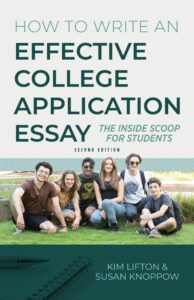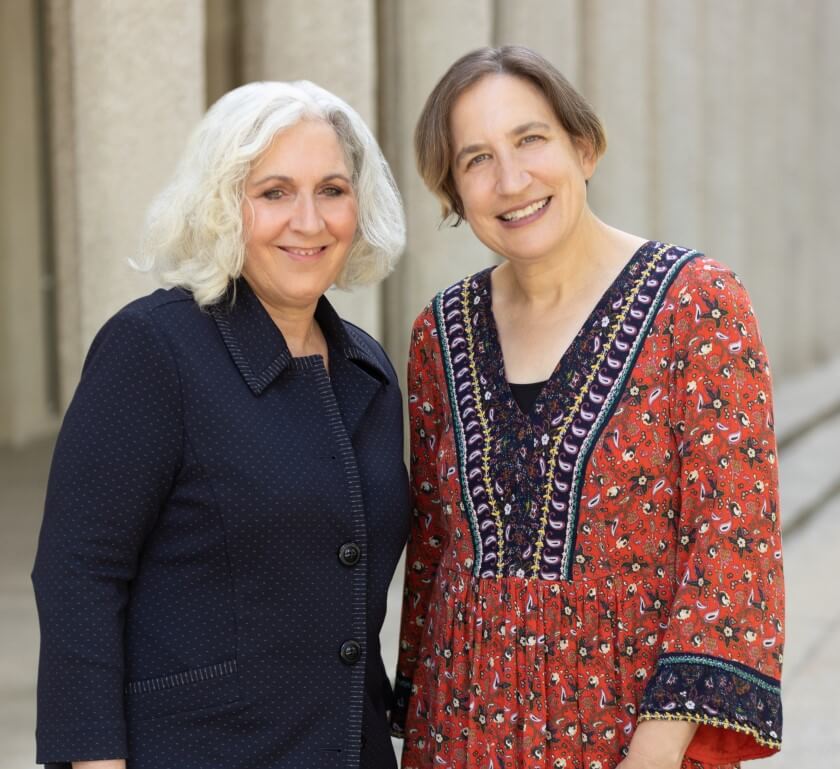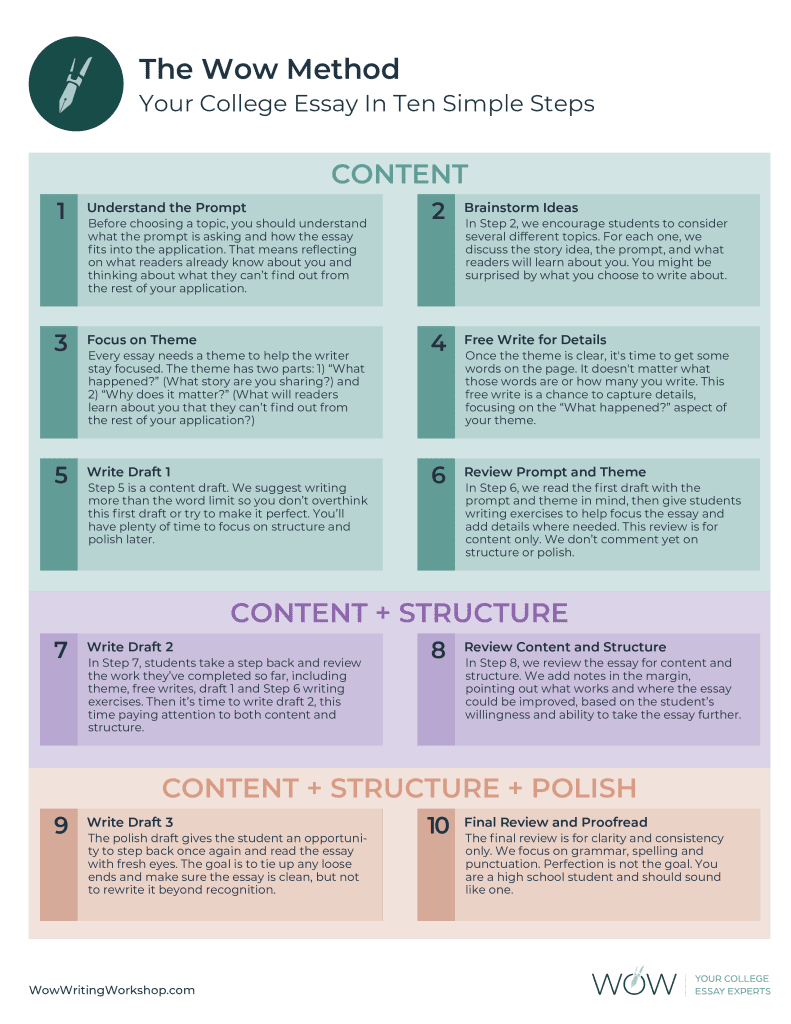
There’s a lot of advice out there when it comes to writing your personal statement for college. We’ve read and heard it all—and if you’re a high school junior or senior planning your own essay writing process, you’ve probably heard it too! But you should be careful about what you believe:
- Some folks share templates for writing standout college essays. (Don’t be fooled. Essay writing is not a fill-in-the-blank task; essay templates don’t help your students complete the task.)
- Others promise that if you answer a bunch of specific questions, you’ll be guaranteed great essays. (Questions can help you think through ideas, but there’s no magic formula. Writing takes time and exploration. No one can do it for you.)
- There are countless books on the market filled with sample college essays that apparently got students just like you admitted into the nation’s most selective schools. (This type of claim is out of context; even the most amazing essay never got a student into college on its own!)
- Some people might tell you there are only a few types of college admission essays; if you master those, you’ll be golden. (That’s too simplistic.)
Trust us—there’s only one type of essay admission officers want to read. And that’s your story written in your own words and in your own voice. Beware of the gimmicks and promises surrounding the college admission essay. We hope you’ll ignore them because there really are no shortcuts.
Before you read more about how to think about and parse any college essay supplemental prompt, consider what you think you know about the college essay. Ask yourself, what if everything I think I know about the college essay is wrong?
There’s a good chance the information you’ve heard is indeed wrong. That’s because a lot of inaccurate and out-of-context information makes its way to you through the Internet, books, blogs, and even inside your high school hallways. It’s so important to get accurate information when you are applying to college. That’s where we come into the picture at Wow. We will always give you the most accurate information regarding the college essay, its purpose, how to write one that is effective and also captures the right kind of attention (the kind you want!) inside the admissions office.
No one knows more than the college essay than Wow.
There’s so much information about college essays out there, how can anyone, even a bright, talented student, tell the difference between what’s worth listening to and what’s not? That’s where I can help. I’m a journalist by training, and I only share information I have checked and double-checked, then checked again.
I go straight to the source – college admissions officers – to find out what they’re looking for in application essays, and I’m excited to share what I know with you. Download a copy of our book for students to learn more.

Read below for ideas on how to answer these types of questions for any type of school.
At Wow, Our College Essay Writing Process IS Our Magic
At Wow, our process is our magic. The Wow Method is simple, effective, and has clear instructions to help you succeed, every time.
We help our students build on their strengths. If you work with us, your college essay writing coach will help you develop an essay that demonstrates your best qualities by guiding you through our 10-step process. We believe that this is the best way to write any number of effective college essays.
We create a custom schedule for every student to help you plan ahead of time; this makes the writing process calmer and more efficient. Each of our coaches are trained fully in the Wow Method, so they have experience with a process that works. The coaches use the process with every student!
We’d like to share a story about one of students, Sophie, who was not the kind of person who typically needs help. She taught herself BC Calculus when it wasn’t offered at her high school. She tutored classmates in advanced chemistry and physics.
When it was time to apply to college, Sophie did the research and picked her own schools. Along the way, she signed up for Wow’s free College Essay class and read our book cover to cover. Imagine her surprise when she sat down to write her essays and still felt stumped! Effective essays could only strengthen her application, and she felt like the ones she was writing didn’t represent her strengths.
Fortunately, Sophie was insightful enough to know she needed help this time. That’s when she called and asked to work with a Wow coach. We got her back on track, guiding her through our process with a plan, simple instructions, and a schedule to tackle all of the writing tasks for four highly selective schools. Her mom was delighted, too. “You are truly a magician!” she said. “Her essays are amazing.”
Related stories:
How to Write the Common App Essay
Top 5 College Essay Myths
What’s The Biggest Mistake Students Make in their College Essays?
Don’t Try So Hard to be “Unique” In College Essay
How to Write Great Supplemental Essays
A Stress-Free Approach to the College Application Essay
Most of our students apply to four or more schools, so we’re used to helping students manage a dozen or more essays. Our scheduling and writing processes were developed with this in mind. Writing so many essays may seem insurmountable at first, but, with the Wow Method, writing becomes much more manageable.
We’ll plan a schedule for all of your essays before you start writing, which will help you stay on track, no matter how much you have to write. There are no gimmicks here—just an effective process that has helped thousands of students write effective college essays.
Learn About the Wow Method

The Wow Method is broken up into ten steps. The first six steps are all about generating content, exploring your story and why it’s meaningful. This phase will likely take up the majority of time you spend on writing any given essay.
Once you are set on content, you’ll move on to the next two steps, which focus on structure. You might still revise some of your content, but in general, this phase is about restructuring the content you already have. You’ll go from the top of your essay to the bottom, reorganizing and reworking until you have a cohesive piece. Exploring content before moving on to structure makes revision easier, instead of trying to focus on both content and structure at the same time. Young writers often make this mistake, making their essay harder than it needs to be.
During the final two steps, you’ll polish your essay and make it shine. At this point in the process, your essay is almost finished. Here, you’ll tie up any loose ends, make the essay more engaging to read, and iron out any minor typos or grammatical errors that may have cropped up along the way. Saving this stage for the end means you don’t have to worry about awkward sentences while you’re still generating content. Oftentimes, those sentences don’t even make it into your final draft, so why worry about them earlier in the process?
By the end of the ten steps, you’ll have an effective college essay that’s ready to be submitted. Each individual step takes a manageable amount of time and effort, making the college essay writing process easier to wrap your head around. Learn more about the Wow process here.

The 10-Step College Essay Writing Process in Detail
Now that you’ve read about the Wow Method’s general stucture, we’ll go through what each step actually looks like. Before you start writing, you’ll meet with a trained Wow coach to discuss how and when you’ll complete upcoming steps, and along the way they will help you understand what each step requires in more detail.
CONTENT (Steps 1 through 6)
Step 1: Understand the Prompt
In this step, you’ll answer a number of questions. To start, which prompt are you responding to? Common App personal statement? Georgia Tech‘s Why Us? Write down the prompt word-for-word so you have it as a resource. Then, consider: What is the prompt trying to find out about you? Parsing the prompt is an essential first step before any writing, or even pre-writing, can effectively be completed.
Finally, you’ll answer two related questions: What do readers already know about you, and what else do you want them to know? Readers already know a lot about you, both from your transcript and from the rest of your application. The college essay is a space to share something new, something readers wouldn’t be able to glean just from knowing what sports you’re involved in or what your ACT score is. Don’t worry about trying to figure out exactly what you’ll be writing about yet—Just list some personal characteristics you’d like readers to know, and stay positive! We can help.
Step 2: Brainstorm Ideas
Before you decide what to write about, you’ll want to explore several ideas. Depending on which essay you are writing, you could approach this task in different ways:
- If you are working on your Common Application essay, you might want to consider several different options from the choices they offer (a background story, a time when you experienced failure, a time when you challenged a belief, etc.), or you might have several ideas in one area (e.g., several background stories, several problems you have solved.)
- If you are responding to a prompt other than the Common Application, keep an open mind and consider various stories that could effectively show readers something meaningful about you.
By the end of this step, you’ll have a few different ideas that could effectively answer your prompt. Then, you will choose your essay topic. You can write about almost anything, as long as the topic feels genuine, fits the prompt, and shows a characteristic. Learn more about Wow Writing Workshop.
Step 3: Focus on Theme
The theme of a college essay includes two parts: 1) What happened? and 2) Why does it matter?
In this step, you’ll answer these two questions for the essay topic that you chose in Step 2. All effective college essays have a clear theme: What happened? (your specific story) and Why does it matter? (the characteristic your story highlights). Your theme will help guide you throughout the rest of the writing process.
Step 4: Free Write for Details
Free writing is an underutilized exercise by many first-time writers. In this step, you will quickly write down as much as you can recall about the story at the center of your essay. Be specific and use all of your senses, but don’t worry about sounding polished or even making sense. If it’s easier, you don’t even need to use complete sentences. The important thing here is capturing details.
Step 5: Write Draft 1
Now that you have chosen a topic and identified your theme, it’s time to start writing your essay! Don’t worry about perfection, word limits or structure. Just get your story down on paper. Remember—The details will help you tell your story. At the same time, keep your theme and your prompt in mind. This will be the first of several drafts, which will gradually develop into a strong and polished essay. Do not try to shortcut the process by focusing on structure and polish too early. We encourage you to write over the word limit in this draft. Generating plenty of content will make it easier to revise and polish later in the process.
Step 6: Review Prompt and Theme
As you move through the content phase of the essay toward the structure phase, it can be helpful to explore the essay’s topic from a few different angles. In this step, you will write outside the essay, instead of trying to revise your first draft directly. You will also write new potential openings for your essay and consider how different starting points would affect your essay’s structure.
CONTENT + STRUCTURE (Steps 7 and 8)
Step 7: Write Draft 2
You’ve now entered the structure phase of the Wow Method. From this point forward, you may revise some aspects of your essay, though a majority of your work will be to restructure the content you already have to make your essay more cohesive and effective.
To begin Step 7, you’ll review your essay and past exercises, highlighting phrases and sections that truly shine—great details, examples of your writing voice, and elements that help you answer the prompt and express your theme. You will also take notes on what you want to improve and change, before moving on to your second draft.
Even if you choose to keep large sections of your first draft, you should retype every word. It may seem easier to just copy and paste, but retyping will force you to slow down and only use the best of your first draft, while making necessary changes. You might also want to use one of your openings from Step 6, or try out a new ending.
Step 8: Review Content and Structure
This step is all about reviewing the draft that you just wrote. Go through your essay and make notes on what you like about the new draft and what still needs to be clarified. It can also be helpful to look back at your work from Steps 5 and 6 as you consider what changes did and did not work. Your coach will do the same and will give you specific feedback on your draft.
CONTENT + STRUCTURE + POLISH (Steps 9 and 10)
Step 9: Write Draft 3
You’re now ready to retype your essay once more from start to finish, keeping your second draft close by as a reference. With an eye on you and your coach’s comments, craft this new draft by keeping what worked in Drafts 1 and 2 and revising as needed.
Along with content and structure, you should be paying attention to clarity and style. Make every word count. You can polish your writing a little bit, but don’t try to sound like anyone else. Keep asking: Why am I telling this story? What do I want admissions counselors to learn about me that they wouldn’t know from the rest of my application?
Step 10: Final Review and Proofread
Your main goal for this step is to finish cleaning up your essay, with an eye toward grammar, spelling, and clarity. That said, perfection is not the goal. Over-editing can actually take away from your essay’s effectiveness. Your essay already has a clear theme, evocative content, and a well-honed structure. Trust the process.
Your coach will proofread your essay to make sure that everything reads clearly and is spelled correctly. Then we’ll send it off to a professional proofreader for a final read. Once you’ve made any necessary changes, your essay is ready to be submitted!
Sample Personal Statement Student Schedule
Week 1 starts Sunday
| PRE-WORK | Date | Task | Who |
| Sunday | Receive welcome email from your coach with link to brainstorm dates | Student | |
| Sunday | Make sure you’ve chosen a brainstorm date | Student | |
| WEEK 1 | Date | Task | Who |
| Sunday | Intro-Step 2: Prework due (1 hour) | Student | |
| Monday | No new assignment | ||
| Tuesday | You will schedule a brainstorm Tues, Wed or Thurs this week, then complete Steps 3-4 after the meeting. Together, this will take about 2 hours. Your coach will respond within a day so you can start writing your first draft. | Student | |
| Wednesday | |||
| Thursday | |||
| Friday | Respond by Friday; assign Step 5 | Coach | |
| WEEK 2 | Date | Task | Who |
| Sunday | Step 5: Content draft due (2 hours) | Student | |
| Monday | Step 6: Assign Write Outside the Essay exercise | Coach | |
| Tuesday | Step 6: Write Outside the Essay exercise due (1 hour) | Student | |
| Wednesday | Step 6: Assign New Openings exercise | Coach | |
| Thursday | Step 6: New Openings exercise due (1 hour) | Student | |
| Friday | Step 7: Assign Plan Your Next Draft exercise | Coach | |
| WEEK 3 | Date | Task | Who |
| Sunday | Step 7: Plan Your Next Draft exercise due (1 hour) | Student | |
| Monday | Step 7: Assign Draft 2 (Content + Structure) | Coach | |
| Tuesday | Step 7: Work on essay | Student | |
| Wednesday | Step 7: Content + Structure draft due (2 hours) | Student | |
| Thursday | Step 8: Respond to Content + Structure draft | Coach | |
| Friday | Step 9: Content + Structure + Polish draft due (2 hours) | Student | |
| WEEK 4 | Date | Task | Who |
| Sunday | Continue working/revise if another draft or more time is required | Coach and Student | |
| Monday | Step 10: Respond to Content + Structure + Polish draft | Coach | |
| Tuesday | Send essay to proofreader | Coach | |
| Thursday | Return essay to student after proofreading | Coach |
Steps 7-10 are flexible, and sometimes require extra drafts
Want to learn more? Download our book for students! It’s packed with information to help you understand everything you need to know to write an effective college application essay, or 10!
Need help on the college essay? Let’s see if we are a good fit!


